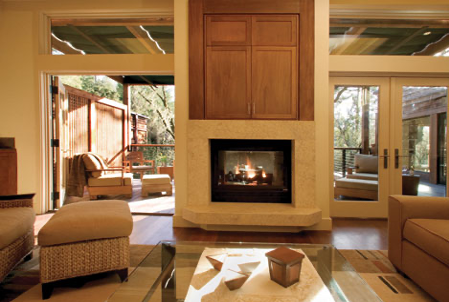
Glamping industry’s business models and supply side
The previous Article in this series looked at the growth in domestic holiday-taking in consequence of the Global Pandemic as well as the consumer profiles of “Glampers” and their motivations for choosing glamping holidays. This article looks at the various business models adopted for glamping projects and the supply side of the industry within North America, the most mature glamping market. Part Two will look at the supply side of the industry in other regional markets as well as the Hotel Brands which have entered the Glamping Industry.
The Glamping Industry’s Primary Business Models
Much of the global glamping market consists of independently run, ‘mom-and-pop’ operations that are then discoverable on various Online Travel Agencies [“OTAs”]. Over time, as the industry has developed, a range of Business Models have evolved, foremost amongst which are:
- SME’s. This will usually be a Developer creating a glamping site on land which is already in his or her ownership, subject to compliance with any local planning regulations. The success of the initiative relies upon the appeal of a specific local attraction such as a pristine location or based around specific activities including wellness, rural crafts, outdoor sports, extreme adventures, learning and education or unique nature-based experiences such as “rewilding” as practiced at the Knepp Castle Estate in the UK[1] which offers shepherd’s huts, bell tents, yurts, and treehouses within a pioneering rewilding environment.
- Add-ons and supplementary accommodations. Developers or Operators may choose to add a glamping component to an established campsite, hotel, or resort to broaden the range of accommodation experiences available to their guests. A prime example of this type of model is Hoxton Hotels, which has three properties in London, four in various locations in the USA plus the Netherlands, France and Italy, launched its Camp Hox concept in 2020. Established initially as a “Pop-Up” with twelve lotus tents, set in the grounds of Eynsham Hall an 18th century estate located in Oxfordshire[2], each tent included a proper bed with duvet and pillows, electricity, an armchair, a Roberts Radio, as well as coffee and tea making facilities. They included the same linens as those used at the Hoxton’s hotels, a private bathroom and shower, and a hot breakfast delivered each morning. The cost was £185 per night for two people (or £2,000 per night if you and 23 friends booked out the campsite exclusively). The success of this venture spawned a range of glamping adventures featuring high-end camper vans in various parts of Europe with pre-arranged itineraries. This “pop-up” approach was driven by the UK climate. There are obviously opportunities for resorts in locations with where seasonality is not a challenge, to add a glamping component so that the camping experience is then dovetailed into the resort’s lodging services and amenities. Opportunities abound within the USA with its varied climate and landscapes, plus Mediterranean countries, Australia, India, and many parts of south-east Asia
- Collective Promoter & Commercial Partner. This category may seem rather broad in scope, but it reflects one of the most successful models established so far for what was initially a domestic market Operator which developed its own set or quality criteria and then began affiliating other global glamping sites which are now promoted on its website. The Company is called Canopy and Stars[3] and it has been one of the leading marketing and booking agents in the glamping industry since 2010. Canopy & Stars began in 2010 as part of Sawday’s, a travel company founded in 1994 with a commitment to finding special spaces and working in a socially and environmentally responsible way. Itscollection of inspiring places to stay in the great outdoors connects independent owners to guests in search of “a life more wild”. Once a Glamping Resort joins the collection, Canopy and Stars becomes its commercial partner, with specialist guest experience, marketing, owner, and business development teams delivering an especially high level of personal service. The Company only accepts around 20% of places that apply to it because quality, authenticity, creativity, and a connection to nature are vitally important when choosing places, as is the need to deliver a genuinely meaningful experience. Its sister company, Sawday’s has given a share of its profits to various charities for the 25 years it’s been in business and Canopy & Stars has also been contributing since it was established in 2010. When founder Alastair Sawday decided to step away from running the company, he wanted to ensure that the social and environmental concern it had been built upon was maintained and strengthened. He moved the business to a unique hybrid model of employee ownership in which employees now own 52% of the Company. The Charitable Trust was established with a 24% stake in Canopy and Stars and the family retaining the balance.
- Franchising. The approach within the glamping sector is not dissimilar to the franchising approach adopted within the mainstream hospitality industry. It may require a landowner to pay an initial fee and commit to purchasing a minimum number of the glamping units from the Franchisor. Once operational, the landowner operates under the applicable franchise brand, is provided with a website and access to a booking engine plus ongoing support from the Franchisor. An example of this approach is Wigwam® Holidays[4] which launched in 2000 and was the UK’s first glamping franchise business. Today it has over 80 rural locations around the UK with a financially proven franchise model – involving a £7,500 Franchise fee, which is due at point of order and lasts for 5 years plus a 10% commission on all bookings generated.
- Smaller Scale, multi-site developments. This approach has gained traction in several markets, for example the Purepods[5] brand in New Zealand which currently offers six pristine rural sites at rates of around NZ$590 per night within its own purpose-built eco-friendly pods which are luxuriously equipped but which expressly exclude TV, DVD’s, Wi-Fi hairdryers and air-conditioning by design.
- Larger scale, multi-site developments. These are, according to the author’s research, with one specific exception, currently found only within the USA where they cater to all elements of the glamping spectrum, with growth having been driven by institutional investment into a segment which is able to demonstrate proven demand. The exception is a privately held company by the name of Huttopia, which will be considered separately later in this article.
- International Luxury Hotel Brands. Participation by Hotel Brands will be considered in later in this article covering brands such as Alila, Aman, Four Seasons, Oberoi, and Rosewood, as well as new, emerging brands. In some cases, tented accommodations have been added to a more traditional luxury hotel to widen the range of guest experiences; in other cases, luxury tented accommodations comprise the entire accommodation stock.
- Event Glamping Companies. These are entities which focus solely on large scale events such as Oktoberfest, Pamplona Bull Running in addition to Music Festivals such as Glastonbury, where they offer complete accommodation packages based upon high quality tented accommodations. Examples would be Companies such as Event Glamping[6], Life in Tents[7] Camp Kerala[8] and Lux Mode. Co[9].
- Mobile Glamping or Pop-ups. This is also an established model found across Europe. It may be an entity such as The Pop-Up Hotel which specialize in Events in the UK, or the Pop-Up BNB in the USA set up by a couple who left their traditional lifestyles back in 2017 and decided to live rather untraditionally ever since. They sold all their belongings, moved into a motorhome, and have spent the past few years traveling full-time with their pop-up tent business. They started small with 1 glamping tent that they would rent out to fund their travels and now we have grown into a full-scale business. Pop-ups are often found in locations with short outdoor holiday seasons, especially in Scandinavia.
Access to Capital and Supply Side
Some market consolidation is now occurring with larger, well-funded entities driving the growth of the glamping segment. The table below lists those entities which have successfully undertaken fund-raising activities to further their expansion.
| Brand | Location | Founded | Funding | Notes[10] | ||
| Autocamp | San Francisco, California | 2013 | $115m | 68,066 hits p/m | ||
| Collective Retreats | Denver, Colorado | 2015 | $41.3m | 61,794 hits p/m | ||
| Getaway | Brooklyn, New York | 2015 | $81.5m | 449,520 hits p/m | ||
| Glamping Hub | San Francisco, California | 2012 | $3.1m | 1,164,583hits p/m | ||
| Hipcamp | San Francisco, California | 2012 | $97.5m | 2,204,244m hits p/m | ||
| Tentrr | New York, New York | 2015 | $17.9m | 136,839 hits p/m | ||
| The Dyrt | Portland, Oregon | 2013 | $11.3m | 1,730,907 hits p/m | ||
| Under Canvas | Belgrade, Montana | 2009 | – | 147,864 hits p/m | ||
Each of these Companies will be examined in turn.
Autocamp[11] According to its website, AutoCamp offers overnight lodging and accommodations in modern Airstream suites and luxurious tents at its locations in Cape Cod, Yosemite National Park, the Russian River Valley, and coming in late 2021 to Joshua Tree National Park. AutoCamp provides high-end, boutique-style amenities, mid-century modern design, and welcoming hospitality to some of the world’s most beautiful natural places. The Company opened its first property in Santa Barbara, California in 2013, adding its second location, in the Russian River Valley, just 90-minutes north of San Francisco. The property was a hit from the day it opened, drawing guests in with its lush, landscaped grounds and Frank Lloyd Wright-inspired Clubhouse lounge and reception building.
AutoCamp caters to travelers who want to experience RV living but do not own a camper. All lodging is provided in the Company’s own customized static Airstream trailers, as well as a few trailer-based cabins and luxury tents. Each location has a unique midcentury-modern-inspired clubhouse made of chicly rustic materials such as black and blond woods, textured natural stone, and blackened steel. A central circular fireplace is always present.
AutoCamp is an officially licensed partner of Airstream, Inc., All unit types are pet-friendly at extra cost. The Airstreams provide approximately 17.65 square meters of interior space. All accommodations feature a king or queen size bed, futon sofa, an outdoor dining area, and cookware specific to each unit type. Airstreams and cabins additionally feature wi-fi, televisions and Bluetooth surround sound. The sites offer a range of experiences and activities such as meditation, yoga, arts and crafts and even extreme adventures. In 2019, it was announced that AutoCamp had raised $115 million through a partnership with private equity firm Whitman Peterson[12]. The funds are anticipated to be used to purchase additional development sites and to purchase and customize more Airstream trailers. The agreement outlined a provision for potential expansion funding of an additional $115 million.
Collective Retreats[13] opened its first property in Vail, Colorado in 2015. Since then, four additional properties have opened, including Wimberley in Texas, Wolcott in Colorado, Big Sky Montana, and Ghent in New York State plus one urban property located on Governor’s Island in New York City, all properties operate seasonally, based on weather patterns. The “resorts” are luxury camps that offer all the amenities and services of a luxury hotel, from 1,500-thread-count sheets to in-room massages, personal concierge, and gourmet chefs. They are portable, so they can be placed on the side of a mountain, in the middle of a vineyard or even inside special venues like museums, to offer that true sense of place that today’s luxury travelers crave. They can also be shuttered or moved during off-seasons, making them much lighter assets than buildings.
Activities are tied to that sense of place, such as horse riding in Vail, fly fishing in Montana and apple picking in the Hudson Valley. These seasonal tents are constructed annually, which provide minimal impact to the surrounding area and have a low environmental impact. Guests have access to daily housekeeping, an adventures concierge, indoor and outdoor fire pits, complimentary activities, and on-site dining options. Each resort’s tent set up varies slightly, but generally feature a wood stove, en-suite bathroom, king bed, and leather queen sofa-bed. What makes Collective Retreats different to many other glamping experiences is the high level of professionalism and traditional luxury hotel operational expertise which the team brings to resorts which are operating in remote areas.
Getaway[14] is a wellness hospitality company that offers cabin rentals in natural landscapes at its various locations which are called “Outposts”. The company opened its first property in the Catskills region of New York in 2016 with 12 cabins. In 2017, Getaway announced a $15 million strategic growth investment from L Catterton, the largest consumer-focused private equity firm in the world. Subsequently, in June 2019, the company announced an additional $22.5 million of Series B funding. Now with 15 Outposts and counting, Getaway offers simple escapes to nature within locations which are around two hours’ drive of major cities across the country — inviting guests to savor their free time, find balance through disconnection, and enjoy the company of those who matter most. Each property features micro recreational vehicles (RVs) which are referred to as “cabins.” The units are manufactured offsite and retrofitted with unique Getaway furnishings, and thoughtfully situated throughout the site to create a private “getaway.”
The cabins feature a “tiny home” layout, comprised of approximately 136 square feet. Each cabin offers one or two queen beds (which are bunked due to space constraints), two-burner cooktop, seating area, toilet, shower, and cookware. Guests access each cabin through a key code that is sent via text message on the day of check-in.
Glamping Hub[15] is the developer and operator of an online booking platform designed to offer camping and alternative accommodations for travelers. Glamping Hub was launched in 2013 as a booking platform for unique accommodations and as a resource for sustainable tourism. Made up of more than 10 different nationalities, its headquarters are based in Denver, Colorado, and Seville, Spain. The company’s platform provides the site visitors with worldwide access to a vast collection of unique outdoor accommodations with nature-based adventures, enabling travelers to stay in camps with the amenities of a hotel. Its website attracts more than 1.1m visits per month according to Crunchbase, where 79% of those monthly visits are from the USA, 8% are from Canada, 4% are from Spain, 3% are from Australia and 2% are from the UK.
Hipcamp[16] was founded in 2013 and is based in San Francisco and since grown into the most comprehensive resource for discovering and booking unique outdoor stays including tent camping, RV parks, cabins, treehouses, and glamping. It has successfully raised USD$97.5m to date to further its growth. It unlocks access to private land for camping and outdoor recreation. It is a mission-driven marketplace where people can list, discover, and book campsites and accommodations on private and public land. Hipcamp helps create new revenue streams for landowners such as farmers, ranchers, and vintners, which supports them to conserve their land and keep it wild. By unlocking access and simplifying the camping experience, Hipcamp is democratizing, and enhancing the experience of getting outside, inspiring more people to enjoy the outdoors. According to Crunchbase, its website receives over 2.2m monthly visits.
Tentrr[17] like Getaway, which rents tiny houses in natural settings, has its own private, plug-and-play lodging sites which means that guests can show up with a toothbrush and spend every minute relaxing in nature. No hauling gear, no wrangling tent poles. Each electricity-free site, located on about 10 acres of private land, includes an extra pop-up dome tent, Adirondack chairs, a picnic table, a fire pit, a grill, drinking water, a solar shower, a wood-burning stove, and a portable, eco-friendly camp toilet. About 70 percent of the company’s 1,000+ listings are these signature sites, starting at $100 a night, but they account for 90 percent of its bookings. The company, founded in 2015 and based in New York City, has locations in 41 states and Puerto Rico, more heavily concentrated in the Northeast. Tentrr, whose sites are also bookable through Airbnb and Expedia, mostly targets young travelers who want to camp within a two-hour radius of home.
The Dyrt[18] founded by a husband-and-wife team launched their camping app in 2017 in response to a lack of available detailed information about campgrounds. It is a free-to-use camping website and top ranked app that offers campsite bookings and over a million photos, reviews, and tips of campgrounds throughout the US. The Dyrt’s mission is to expand the camping community and help more people enjoy the outdoors. With over 2.5 million user-generated campgrounds, reviews, and tips, The Dyrt is a vast resource for camping information. The Dyrt helps campers find their ideal destinations by collecting reviews, photos, and videos from fellow campers through the app. The Dyrt PRO enables campers to plan road trips, find free camping areas on public lands, use the app offline and more. The premium membership, The Dyrt PRO, is an optional $36 annual subscription that makes going camping easier with a trip planner, offline search, public land map layers as well as discounts on campgrounds and gear. The Dyrt PRO is the largest and fastest growing consumer subscription service for campers in the USA. It garners over 1.7m site visits per month according to Crunchbase. The newest feature of The Dyrt PRO is a cell coverage map rating the signal for each carrier at thousands of campgrounds across the USA along with The Dyrt PRO’s road-trip planner.
Under Canvas[19] began in 2012 with a camp in West Yellowstone, dedicated to connecting guests with the outdoors and to each other through experiences in nature. It has since grown to include nine upscale glamping locations with another location to be added at Bryce Canyon in 2022 as well as customized pop-up glamping experiences. A leader in upscale, outdoor hospitality, Under Canvas has claimed awards from the likes of Condé Nast Traveler and Travel + Leisure as amongst the best resorts in the USA. The Company’s spatially distanced, safari-inspired tents include amenities such as daily housekeeping and fresh towels, king-size beds, plush linens, en-suite bathrooms, USB charging packs, bedside lanterns, hot running water and even a wood burning stove for chilly nights.
Expansive main lobby tents and adjoining patios provide a communal space to enjoy meals from the café style kitchens and an opportunity to purchase retail items to enhance guests’ stays. Under Canvas utilizes thoughtful enhancements across its camps designed to elevate the guest experience including curated adventure programming, culinary innovation, and localized design aestheticthat reflects the surrounding natural environment. Complimentary programming ranging includes yoga classes and crafts plus acoustic live music and outdoor games.
Wi-fi is intentionally not offered to guests, so that they can disconnect from technology and reconnect with others. Environmental consciousness is evidenced through installation of pull-chain showers, faucets that shut off automatically, low-flow toilets and a towel reuse program so that its camps use significantly less water and energy than a hotel of similar size. Additionally, low level lighting is used throughout camps, mitigating light pollution, and amplifying the night sky. The Company’s mission is “to inspire connections with extraordinary places, people and the planet by enhancing access to the outdoors”
Industry Supply Side
It is extremely difficult to get an accurate fix on the precise number of glamping projects currently in existence, according to the author’s research, there is no existing database which catalogues these projects either by country, by type [mountain, lake, forest, wilderness, beach] or by accommodation type, e.g. “A” frame, cabin, hut, safari or bell tent, pod, treehouse, yurt, and so forth. To provide an over-simplified response to the question “How many glamping projects are there around the world?” the author has looked specifically at GlampingHub.com which appears to have the largest listing of Glamping projects of any of the dedicated websites and the results, based solely upon glamping accommodation type, are shown in the table below:
Glamping accommodations by type, in alphabetical order
| “A” frame: 167 | Airstreams: 134 | Barns: 168 | Beach Houses: 530 | Bell Tents: 554 | Boats: 27 | Bubbles: 65 |
| Cabins: 8,337 | Cabooses: 57 | Castles: 27 | Caravans: 390 | Caves: 77 | Containers: 67 | Cottages: 12 |
| Domes: 232 | Floating Homes: 85 | Huts: 497 | Hobbit Houses: 16 | Igloos: 10 | Log Cabins: 974 | Luxury Tents: 910 |
| Luxury Tree: Houses 473 | Nature Lodges: 4,763 | Pods: 167 | Private Islands: 28 | Safari Tents: 615 | Tipis: 162 | Tented Cabins: 478 |
| Tiny Houses: 465 | Towers: 38 | Villas: 683 | Yurts: 532 |
Source: Glampinghub.com September 2021
This table provides an indication of the numbers and diversity of glamping accommodations with cabins and nature lodges the clear leaders but, the totals are likely to be much higher, as there are notable omissions on this website, for example, with sites operated by international hospitality brands.
The North American Glamping market is by far the largest and most mature with some established brands already demonstrating strong growth, in sharp contrast to the fragmented industry found in most other markets. The entities which have secured funding are a mix of multi-site Developers and Operators and specialist online rental or camping information portals. Given the spread and diversity of the global Glamping Industry, it is beyond the scope of this article to try to catalogue every glamping project. Proprietary research is available which segments the industry by glamping accommodation type, consumer demographics, as well as by region, with accompanying growth forecasts. This article is intended to provide insights regarding the industry’s main players as well as its geographical diversity but with obvious limitations.
Mention was made earlier in this Article of a Company by the name of Huttopia which deserves special coverage. Huttopia is an independent family business, established in Lyon, France in 1999. The business took root in the Drôme area after setting up an initial small nature campsite in the Alps in 2000 and then matured in Canada, where the founders had lived for some time. Today Huttopia is active on 3 continents, in Europe for the past 20 years with a head office in Lyon, in North America for 10 years with a head office in Montreal, and in China for 5 years with a head office in Shanghai. Huttopia’s philosophy embraced social distancing by design long before its more recent advent. The Company’s original vision was based upon three specific observations, namely
- People all over the world were living lives that were increasingly urbanized, artificial, digital, in short, intermediated, that cut them off from nature…
- All over the world however, people still had a natural, basic desire to explore and immerse themselves in unspoiled natural environments, to feel their feet in the grass, to touch the trees…
- All over the world, we are witnessing, in parallel, increasing awareness of the value of the natural environment which is prompting governmental protection of more and more natural areas.
A key building block in Huttopia’s success has been its ability to work in collaboration with National Parks and managers of natural areas. In France, since the year 2000, the Company has been developing a partnership and sites in National Forests run by the French National Forestry Commission. In Canada in 2008, the Company set up sites in the National Parks of Quebec. In 2013, it began development in China with the STG (Sichuan Tourism Group). Since 2018, it has been working with the Staatsbosbeheer, the Forest Manager and National Parks in the Netherlands and in 2019 it began working with National Parks in Argentina. Other projects are under way in Morocco, Japan, Bulgaria, and Georgia.
Huttopia positions itself as a global brand in the field of ecotourism, representing a lifestyle and values that are respectful of nature and curious about other people’s cultures. It is a decentralized organization whose primary unit is its sites. It is thus organized around sites, divisions, and branches, which are linked by clearly set common objectives, shared values, and a highly efficient information system. Since the year 2000 Huttopia has developed its own digital know-how, [“Huttosoft”] and since 2004 its own industrial know-how, [“Hékipia”].
The Company’s international debut in Canada in 2008 involved the establishment of sites in the National Parks of Quebec through a partnership with the Sépaq which is the agency of the Government of Quebec that manages parks and wildlife reserves. This facilitated the pitching of about 500 Huttopia tents, in the form of bivouacs in about twenty National Parks. It was an immediate success, allowing the Sépaq to considerably expand its “ready-to-camp” business. Huttopia’s reputation grew significantly in Quebec. People started going “Huttopia” camping. This was the beginning of Huttopia’s North American adventure. Today Huttopia has a base camp in Montreal with a team of staff working on its development in North America. With three Huttopia villages in operation in Quebec, New Hampshire, and Maine, three sites under construction in the State of New York and two in California, Huttopia has taken off and is one of the main players in glamping holidays in the USA.
Huttopia then began development in China in 2013 where it launched a first pilot project in 2015 under its indigo brand in Sichuan in association with the Sichuan Tourism Group. It went on to open a new site in Huashan near the ancient capital Xi’an in Shaanxi Province. Huttopia, which focuses in China on the creation and management of sites, has designed a dozen nature campsites. A beautiful Huttopia site is being set up near Hangzhou, to be opened in 2021. Huttopia China has its headquarters in Shanghai, its base camp.
Huttopia also began development in the Netherlands in 2016 with a commercial branch and then new sites in 2019. A partnership was signed with the National Park Manager, the Staatsbosbeheer, to create an exceptional Huttopia in the NewLander National Park. Other projects are being studied in Belgium and Germany. In Argentina, the Company has been working with the government for the past two years to establish new Huttopias in beautiful natural areas throughout this vast country, especially in the National Parks. Other projects are under way in Morocco, Japan, Bulgaria, and Georgia.
In North America, Huttopia has five resorts, one in Canada (Sutton, Quebec) plus two in New England, all immersed in nature and wooded settings, as is the company’s aesthetic. Each occupies at least 40 outdoor acres and features a variety of private accommodations and onsite activities such as kayaking and heated outdoor pools. Huttopia White Mountains was the first Huttopia in the United States, opened in June 2017. It is located in New Hampshire near North Conway, less than two hours’ drive from Boston; Huttopia Adirondacks is located within the six-million-acre Adirondack Park, offering high mountain peaks, thousands of miles of hiking trails and canoe routes, and numerous scenic highways and byways; Huttopia Southern Maine is located 15 miles inland from the famed seaside towns of Kennebunkport and Wells and Huttopia Paradise Springs sits in the heart of the San Gabriel Mountains, near Valyermo in southern California.
The US resorts offer a mix of safari-style tent, cabin, and tiny house accommodations, all with electricity, running water and private bathrooms with showers. Their Trappeur Tents have small kitchenettes and private decks with firepits. The cabins have the same but more of it (full kitchen, outdoor dining table), and they also offer Vista Tiny Houses, designed specifically for Huttopia, with more modern features, barbecue grills, and glass enclosed indoor/outdoor spaces with sliding doors. Being a French company, they also include breakfast comprising items like croissants, pastries, and espresso. Like most better glamping options, Huttopia is also dog friendly. The US resorts are usually open during specific seasonal windows
Huttopia’s commitment to prioritizing consideration for the environment in the development of its sites, has opened opportunities for Huttopia in National Parks and other protected areas around the world. The strength of the Huttopia brand makes it possible to attract eco-tourists looking for alternative tourism to areas that are often rural and not always touristic. In 2020, Huttopia offered 57 sites around the world, in 5 countries, on 3 continents and the aims to add 5 to 7 new destinations each year. Huttopia has also established a Foundation, the purpose of which is to encourage entrepreneurial, cultural, educational, and social activity related to the development of responsible tourism, demonstrating that nature is good for people and that it must be taken care of, and that people are enriched by contact with others.
Unique or Outstanding Resorts in the USA which feature Glamping
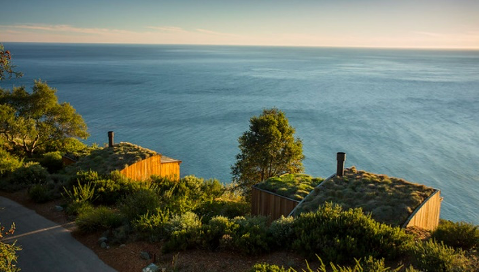
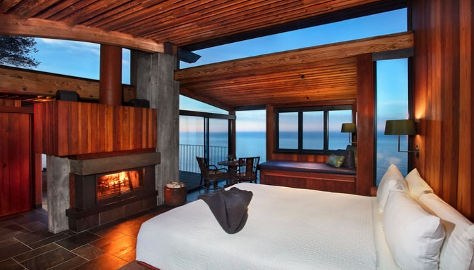
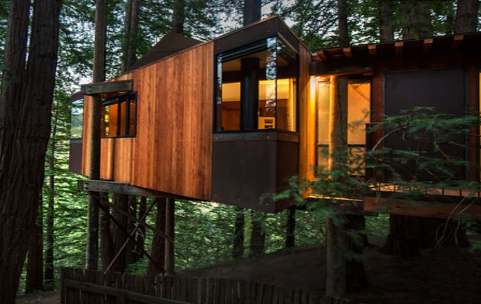
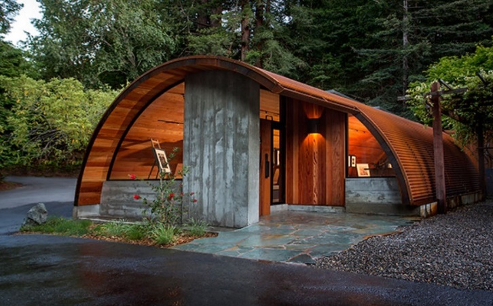
The USA is also host to many standout luxury resorts within the United States which were already providing unique accommodations well before the term “Glamping” was coined. A prime example would be the Post Ranch Inn on Big Sur, near Carmel, south of San Francisco [www.postranchinn.com]. The location has spectacular views out over the Pacific Ocean as well as the mountains behind the Retreat with an excellent onsite restaurant and a superb range of accommodations, as shown in the photographs below.
Another example of what can validly fall into the “Glamping” category was the Calistoga Ranch, located in the upper reaches of the Napa Valley and located just off the Silverado Trail, which included 47 guest houses, hiking trails, a vineyard, wine cave, shops, and other luxury amenities, opened in 2004 as a destination resort operated by Auberge. Instead of traditional rooms, Calistoga Ranch was composed of 47 freestanding one- and two-bedroom guest lodges, with each lodge resembling a wooden cabin, with sweet-smelling cedar, spectacular interiors, and indoor and outdoor showers.


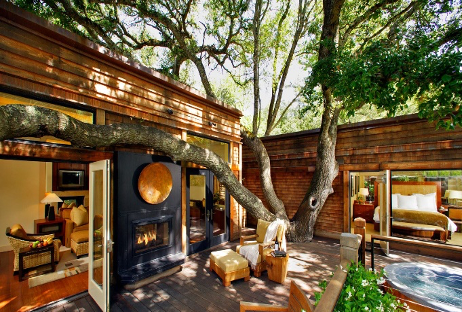

Because it’s hugely challenging to secure approvals for new commercial development in Napa County, the Developers behind the $130 million Calistoga Ranch had to finesse their upscale Wine Country retreat into existence. The result: 157 acres of very high-end hotel bungalows and fractional ownership residences, all of which were built offsite and brought in on wheels. They had attached axles and vehicle identification numbers to conform to California’s motor vehicle code. The wheels on each trailer were discretely hidden behind low wooden fencing. The Developers also implemented a very successful fractional ownership business model. The fractional ownership units consisted of 3,000 square feet, featuring two generously proportioned sleeping pods, a living room pod and a kitchen pod, all surrounding a covered outdoor patio area with wood-burning fireplace and sofas.
Living within this arboreal heaven initially cost $385,000 for a tenth share, which provided at least three weeks of usage per year whilst the cost of a fifth share, or at least six weeks per year, opened at $635,000. Most of the fractional interests were sold to affluent folks living within the San Francisco Bay area. Readers will notice that the description of this development uses the past tense. This is because the development was destroyed in what was known as the Glass Fire of 2020. It is hoped that it will be rebuilt at some point in the future, given its unique location and characteristics. It demonstrated the success of applying a fractional ownership model to a truly unique recreational vehicle concept, within a pristine location and within reach of a huge metropolitan consumer market.
Glamping accommodations have also been added to existing luxury resorts with great success. An example is the Ventana Resort[20]. The property had opened back in the 1970’s in the heart of the California Central Coast’s rugged landscape. It was set among 160 acres of rolling meadows, towering redwoods, and Pacific Ocean views. The Resort underwent an extensive “reimagination” ahead of its 2017 re-opening to mark the entry of the Alila brand to North America. Alila means “surprise” in Sanskrit, which suitably describes the refreshing character of the brand’s properties. In support of sustainable tourism, Alila properties adopt EarthCheck operating standards, integrating the natural, physical, and cultural elements of their environments. The resort features 59 guest rooms, suites and villas, Spa Alila, two pools with outdoor Japanese hot baths, The Sur House restaurant, Social House, Glass House Gallery and 12,000 square feet of event and meeting space surrounded by the stunning beauty of Big Sur to which a Glamping component has also been added.
The new glamping program in Ventana’s redwood forest offers a rustic-luxury twist on traditional camping. Fifteen safari-style, canvas tents spanning a 20-acre canyon feature inspired cabin style décor, a custom-designed plush glamping mattress with luxury hotel linens and other comforts. Glampers can experience the splendor of the outdoors while still relishing all the amenities and services of a world-class resort, including daily housekeeping service, nightly turndown service and more. The brand-new glamping Bath House offers a more refined outdoor experience with teak-enclosed showers with subway tile, heated floors, full hotel amenities, marble vanities and restroom facilities.
Other standout resorts in North America include The Resort at Paws Up®[21] located within a 37,000-acre ranch—that’s about 60 square miles—featuring untamed Montana wilderness. Situated on 10 miles of the legendary Blackfoot River (as featured in the film “A River Runs Through It”), the Resort at Paws Up opened in June 2005 and boasts more than 100 miles of designated hiking, mountain biking, horse and ATV trails as well as a plethora of outdoor activities. There are accommodations for up to 275 guests in 28 luxury homes and 36 glamping tents (with seasonal availability). The tents are spread across six luxury campsites, including Moonlight, Creekside, Pinnacle, Riverside Camp, Cliffside Camp and, the newest, North Bank Camp, with tents each individually decorated in a Western-chic style with furnishings and artwork hand-selected by the owners. For something more sedate, there are treatments available at Spa Town, the resort’s tented spa. The ranch also has a private-air transfer partnership with XOJET. The table below provides details of each of the six camps, the size of the tented accommodations and the range of services available at each camp, including a camping butler and chef!
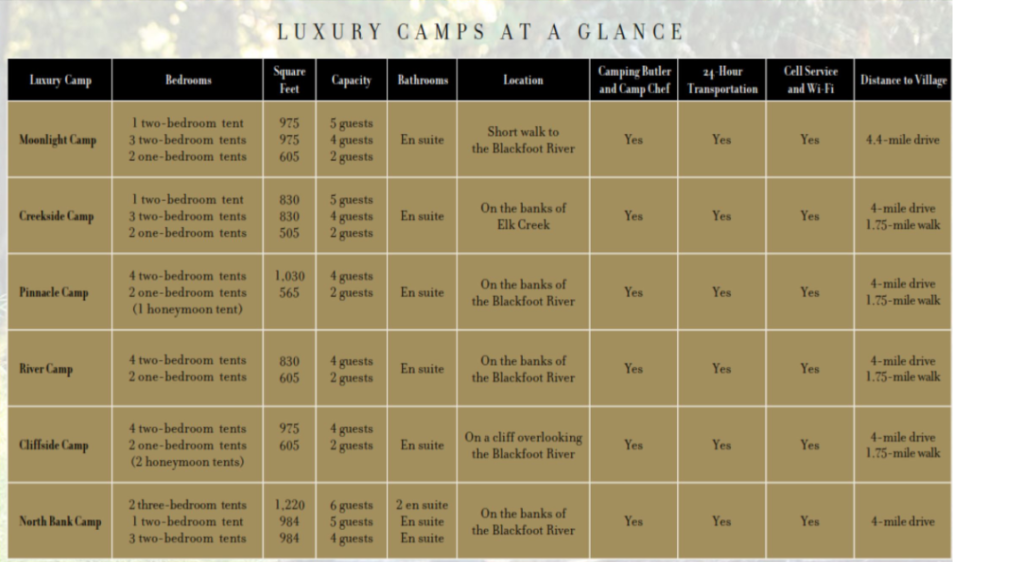
There has been another addition to the uber-luxury end of the US glamping scene with the arrival of Camp Sarika, the long-awaited sibling of developer Canyon Equity’s Amangiri Resort which opened in 2009 in Canyon Point, Utah. This 78-acre unearthly desert site is billed as the first all-weather, year-round luxury camp in North America. Only ten super exclusive tents or “Pavilions” as they are known, focused on sustainability, and integrated into the environment were built at Camp Sarika whose name means “open air space”. The tarps that cover the accommodations were made with recycled plastic bottles. The interior is minimalist, with furniture also in harmony with the surroundings made of stone, leather, and wood.
The site is surrounded by 600 acres of wilderness and opened on 1st July 2020 and is a 30-minute hike or a five-minute drive from nearby Amangiri, Camp Sarika comprises five 1,900-square-foot one-bedroom tents and five 2,800-square-foot versions with two bedrooms, designed by Luxury Frontiers. Each tent includes living and dining areas; wet and dry bars; bathrooms with tub; indoor and outdoor showers; heated plunge pool; firepit; and a deck shaded by an extended canvas overhang. Construction materials and methodologies were chosen for their minimal impact and ability to blend almost invisibly with the sandstone mesas.
Each pavilion is formed from inner and outer coverings stretched across a timber frame with concrete as a foundation. The fabric for the exterior tent and overhangs is a UV-rated, high-tensile PVC membrane that can withstand 115 mph wind gusts and up to two feet of snow.
The photos below are views of the Camp Sarika Pavilions.
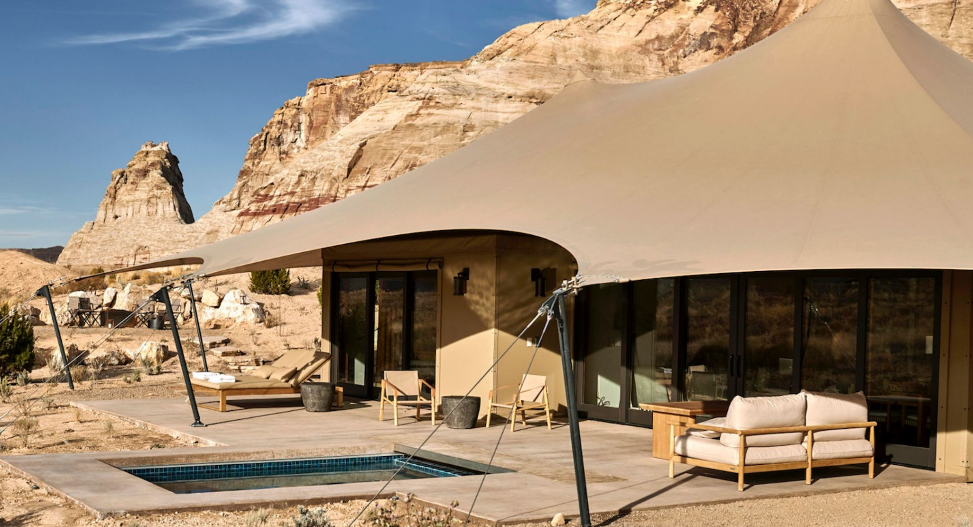

The range of glamping experiences within North America is virtually boundless given the size of the Continent, its varied climate and typography, its network of highways as well as its expansive National Parks and a population with a strong affinity for the Outdoors. Article five provided some insights into the demographics of “Glampers” in North America and as the industry becomes more mainstream and more segmented, there will be many more new Glamping sites developed to meet growing consumer demand.
Article Six, Part Two will look at the supply side in other regional markets, as well as the various Hospitality Brands which have embraced the Glamping concept.
[1] www.kneppsafaris.co.uk/stay/camping
[5] www.purepods.com
[7] www.lifeintents.com/pages/glamping-events
[8] campkerala.com
[9] luxmode.co
[10] The details under this heading were obtained from the Crunchbase website on the 5th of September 2021 and indicate the numbers of monthly site visits to the individual entity’s websites.
[11] autocamp.com
[12] whitmanpeterson.com
[13] www.collectiveretreats.com
[14] getaway.house/about
[15] glampinghub.com
[16] www.hipcamp.com/en-US/about
[17] www.tentrr.com
[18] thedyrt.com
[19] www.undercanvas.com
[20] www.ventanabigsur.com/resort/overview
[21] www.pawsup.com
